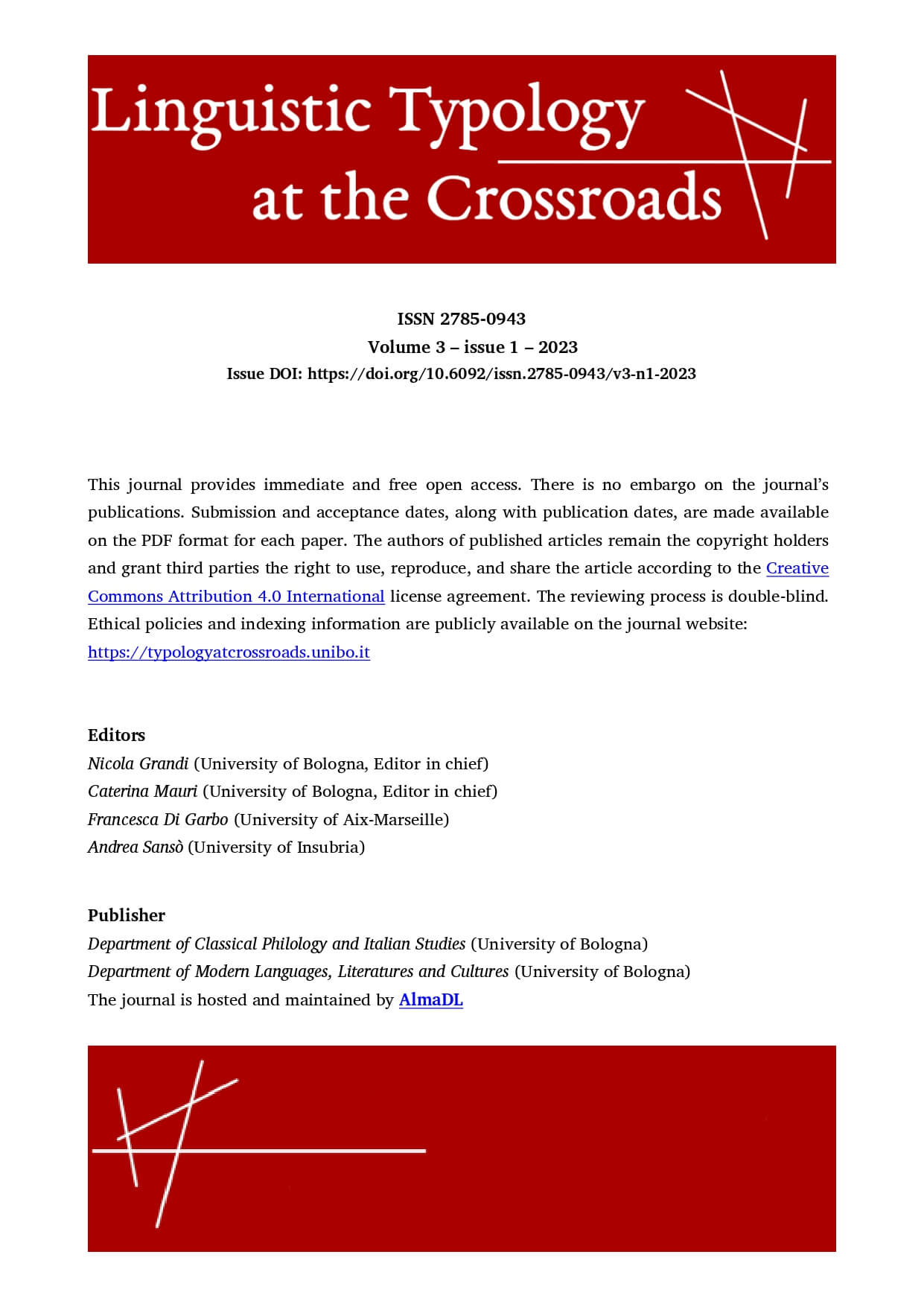Language contact and evidence of divergence and convergence in the morphology of Usaghade
DOI:
https://doi.org/10.6092/issn.2785-0943/16309Keywords:
noun classification/agreement, language contact, Lower Cross, Londo, contact-induced changeAbstract
Usaghade, a Lower Cross (LC) language is, unlike other LC languages, in regular contact with several Bantu languages, particularly Londo, and has a functioning system of noun classification/agreement, whereas other LC languages have only remnants of a former system. A comparison of noun classification in Lower Cross and Usaghade and between Usaghade and Londo suggests that Londo may have played a role in shaping the noun classification system of Usaghade by providing, along with other neighboring languages, an ecology in which Usaghade speakers were able to maintain their own existing system rather than converge with Londo. Usaghade temporal marking and its apparent system of verb classification, also different from other LC languages and hardly attributable to contact-induced convergence, might be a result of contact-induced divergence. The situation of Usaghade supports the view that bound morphology is resistant to borrowing and suggests three possible outcomes of contact: convergence, divergence, and stability.
Downloads
References
Aaron, Uche. 1994. Tense and Aspect in Obolo Grammar and Discourse. Santa Barbara: University of California. (Doctoral dissertation.)
Ardener, Edwin. 1968. Documentary and linguistic evidence for the rise of the trading polities between Rio del Rey and Cameroons, 1500-1650. In I. M. Lewis (ed.), History and Social Anthropology, 81–126 London: Tavistock.
Barnwell, Katie. 1969. The Noun Class System in Mbembe. Journal of West African Languages VI, 51–58.
Braunmüller, Kurt & Steffen Höder & Karoline Kühl (eds.). 2014. Stability and Divergence in Language Contact: Factors and Mechanisms. Amsterdam: John Benjamins.
Corbett, Greville. 1991. Gender. Cambridge: Cambridge University Press.
Connell, Bruce. 1987. Noun classification in Lower Cross. Journal of West African Languages 17, 110–125
Connell, Bruce. 1995. The historical development of Lower Cross consonants. Journal of African Languages and Linguistics 16, 41–70.
Connell, Bruce. 2001. The role of language contact in the development of Usaghade. In Nurse, Derek (ed.) Historical Language Contact in Africa (SUGIA / Sprache und Geschichte in Afrika vol. 16/17), 51–81. Köln: Rüdiger Köppe Verlag.
Connell, Bruce. To appear. Cross River. In Watters, John R. (ed.) East Benue-Congo: Reconstructions and Bantoid Classification. Niger-Congo Comparative Studies 4. Berlin: Language Science Press.
Connell, Bruce & Kojo B. Maison. 1994. A Cameroun homeland for the Lower Cross languages? SUGIA (Sprache und Geschichte in Afrika) 15, 47–90.
Eberhard, David M. & Gary F. Simons & Charles D. Fennig (eds.) 2022. Ethnologue, 25th Edition. Dallas, Texas: SIL International. Online version: https://www.ethnologue.com
Essien, Okon E. 1990a. Aspectual character of verb and tense in Ibibio. Journal of West African Languages 20. 64–72.
Essien, Okon E. 1990b. A Grammar of the Ibibio Language. Owerri: University Press Limited.
Essien, Okon E. 1991. The tense system of Ibibio revisited. Afrikanistische Arbeitspapiere 27. 99–128.
Faraclas, Nicholas G. 1984. Obolo Grammar. Bloomington: Indiana University Linguistics Club.
Faraclas, Nicholas G. 1986. Cross River as model for the evolution of Benue-Congo nominal class/concord systems. Studies in African Linguistics 17. 39–54.
Güldemann, Tom & Ines Fiedler. 2019. Niger-Congo “noun classes” conflate gender with deriflection. In Francesca Di Garbo & Bernhard Wälchli (eds.), Grammatical Gender and Linguistic Complexity. 85–135. Berlin: Language Science Press.
Güldemann, Tom & Ines Fiedler. 2021. More diversity enGENDERed by African languages: an introduction. STUF - Language Typology and Universals. 74(2). 221–240.
Hammarström, Harald & Robert Forkel & Martin Haspelmath & Sebastian Bank. (eds.). Glottolog 4.7. https://glottolog.org.
Hedinger, Robert. 1987. The Manenguba Language (Bantu A.15, Mbo cluster). London: School of Oriental and African Studies.
Huson, Daniel & David Bryant. 2013. Splitstree4 version 4.13.1. www.splitstree.org.
Kastelein, Bianca. 1994. A Phonological and Grammatical Sketch of DuRop. Leiden: Leiden University. Scriptie.
Kuperus, Julianna. 1978. Esquisse du système verbal de l'oro du Nigeria. Paris: Sorbonne, Université Paris V – Rene Descartes. Thèse de IIIe cycle.
Kuperus, Julianna. 1985. The Londo Word: Its Phonological and Morphological Structure. Musée Royal de L'Afrique Central.
Kühl, Karoline & Kurt Braunmüller. 2014. Linguistic stability and divergence: An extended perspective on language contact. In Kurt Braunmüller & Steffen Höder & Karoline Kühl (eds.), Stability and Divergence in Language Contact: Factors and Mechanisms. 13–38. Amsterdam: John Benjamins.
Latham, Anthony J. H. 1973. Old Calabar 1600–1891. The impact of the international economy upon a traditional society. Oxford: Clarendon Press.
Laycock, Donald C. 2001. Linguistic diversity in Melanesia. A tentative explanation. In Alwin Fill & Peter Mühlhäusler (eds.) The Ecolinguistics Reader. 167–171. London: Continuum.
Mous, Maarten. 2001. Ma’a as an ethno-register of Mbugu. SUGIA (Sprache und Geschichte in Afrika) 16/17. 293–320.
Rowland-Oke, Mary. 2003. Description systématique de la langue Obolo-Andoni. Paris: Harmattan.
Saitou, Naryua & Masatoshi Nei. 1987. The Neighbor-Joining method: a new method for reconstruction of phylogenetic trees. Molecular Biology and Evolution 4. 406–425.
Sterk, Jan P. 1976. The Hohumono Noun Class System. Journal of West African Linguistics XI. 119–140.
Thomason, Sarah Grey. 1983. Genetic relationship and the case of Ma’a (Mbugu). Studies in African Linguistics 14. 193–231.
Thomason, Sarah Grey & Terrence Kaufman. 1988. Language Contact, Creolization and Genetic Linguistics. Berkeley: University of California Press.
Welmers, William. 1966. Efik. Obot Idim (Uyo): Lutheran Mission. Also published in 1968 by the Institute of African Studies, Occasional Publication No. 11, University of Ibadan.
Williamson, Kay & Roger M. Blench. 2000. Niger-Congo. In Bernd Heine & Derek Nurse (eds), African languages: An introduction. 11–42. Cambridge: Cambridge University Press.
Winston, F. Dennis. 1962. The nominal class system of Lokə. African Language Studies 3: 49–70.
Downloads
Published
How to Cite
Issue
Section
License
Copyright (c) 2023 Bruce Connell

This work is licensed under a Creative Commons Attribution 4.0 International License.





